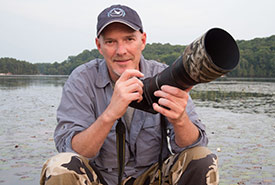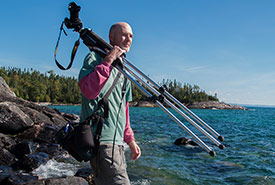How a hidden forest valley is a big opportunity for conservation

Photo assignment for NCC is a journey into a pristine habitat that will make a difference in southwestern Ontario. (Photo by Gregg McLachlan)
Towering hemlocks reaching for the sky. A deep and rugged valley covered with ferns. A coldwater stream flowing over and under moss-covered fallen pine trunks.
Just the thought of these scenes makes my mind wander yet again to northern destinations, hundreds of kilometres off the beaten path in Ontario. I love hiking these landscapes, usually with a 40-pound backpack loaded with camera or video gear.
The excitement of seeing plants and wildlife and what’s around the next corner pushes me to keep hiking forward. The lures are many. It might be a stand of black spruce on the horizon, hearing a loon on a lake that I can’t immediately glimpse beyond the cover of the forest, or a giant granite cliff temporarily obstructing a wider view.
Yet, for all these memorable northern hikes, many incredible and vital landscapes are much closer than we think.
Very close.
You see, the opening paragraph of this article isn’t about up north. It’s about a special place down south.

The opportunity to go out and experience nature is a treasured part of my job. (Photo by Gregg McLachlan)
In the autumn of 2017, I did a photography assignment for the Nature Conservancy of Canada. The location was in Norfolk County in southwestern Ontario. It’s a Lake Erie shoreline region of the province mostly known for its flat sandplain landscapes. But it also has a storied history of restoring forest cover after most forests were clearcut during the lumber heydays of the 1800s.
Tucked away in those vast flat landscapes and forests are special places. You just need to look harder for the rugged valleys with towering hemlocks. They are behind farm fields, or hidden down sandy roads that eventually become hugged by deep Carolinian forests.
The destination on this day was that serene valley described in the opening paragraph. The photography assignment was all about capturing its beauty.
The valley is part of an extensive forest corridor spanning multiple counties. Think of it in terms of being a wildlife highway. When habitats like this are protected, they become vital for so many species to move freely for food, reproduction, pollination, hibernation and so much more, without human interference. Without habitat protection, species become contained and isolated. And that leads to population declines.
From the dusty concession road where I parked, I’m sure the many daily passing motorists don’t know this natural oasis exists so close. For me, it was a walk of a few hundred metres beyond a corn field to reach it. When I finally laid eyes on it, it was a wow moment. “It’s like being up north,” I remember thinking.
Within minutes of standing in the fallen autumn leaves covering the treed valley edge, I spotted the white tail flash of a deer dashing away to seek sanctuary deeper into the valley.
Hiking down the steep slopes, and using my tripod as a trekking pole to avoid a fall, I reached the bottom of the valley, where I began to photograph the beauty of this place. It was vibrant. I couldn’t help but think I had entered the depths of an ancient landscape carved long ago. Indeed, I had. In between shots, I would lift my head and my eyes would follow the stream’s path as far as I could see — beyond the hemlocks and old logs crisscrossing its path. I imagined what I might find around the next bend.
More wildness stretched far. And even more wildness beyond that.
Hiking back to my car at the end of the day, this valley left an incredibly powerful impression on me. Perhaps that’s because in the course of doing nature photography work, one tends to dwell on scenes. But that’s not the only reason. I think back to that white-tailed deer. How far had it travelled along that forested valley? Or the many other animals that no doubt watched my presence that day, but that I never saw?
I can’t fathom places existing so close to home,where the ability of wildlife to freely move back and forth along a forest corridor is lessened by loss of habitat. Thankfully, I know this valley system won’t let that happen. And it will be in good hands.
That day, I travelled a different kind of highway in the making. It will become part of a super highway for wildlife. And when it does, I will look back fondly on the day I travelled its streambanks and watched that deer disappear into the deep forest.
Get a glimpse of Gregg doing what he loves...spending time in nature.


